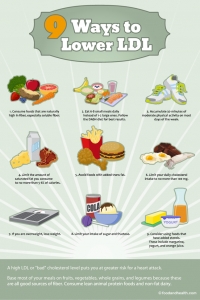Skip Saturated Fat
What Is Saturated Fat?Saturated fat is a type of fat that's usually solid at room temperature. According to the Dietary Guidelines for Americans, "The body uses some saturated fatty acids for physiological and structural functions, but it makes more than enough to meet those needs. People therefore have no dietary requirement for saturated fatty acids."In other words, there is no nutritional need for people to consume saturated fat.In fact, the United States Department of Agriculture's (USDA) Center for Nutrition Policy and Promotion (CNPP) has stated "Saturated fatty acids [...] and trans fatty acids are generally considered unhealthy."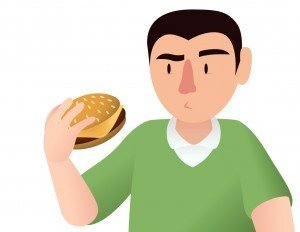 What Foods Contain Saturated Fat?Despite the fact that no one actually needs to consume saturated fat, this fat is everywhere. It's most commonly found in cheeses, desserts, and meat dishes. The Dietary Guidelines for Americans explain, "Animal fats tend to have a higher proportion of saturated fatty acids (seafood being the major exception)."Take a look at this chart of common sources of saturated fat. What do you notice?
What Foods Contain Saturated Fat?Despite the fact that no one actually needs to consume saturated fat, this fat is everywhere. It's most commonly found in cheeses, desserts, and meat dishes. The Dietary Guidelines for Americans explain, "Animal fats tend to have a higher proportion of saturated fatty acids (seafood being the major exception)."Take a look at this chart of common sources of saturated fat. What do you notice?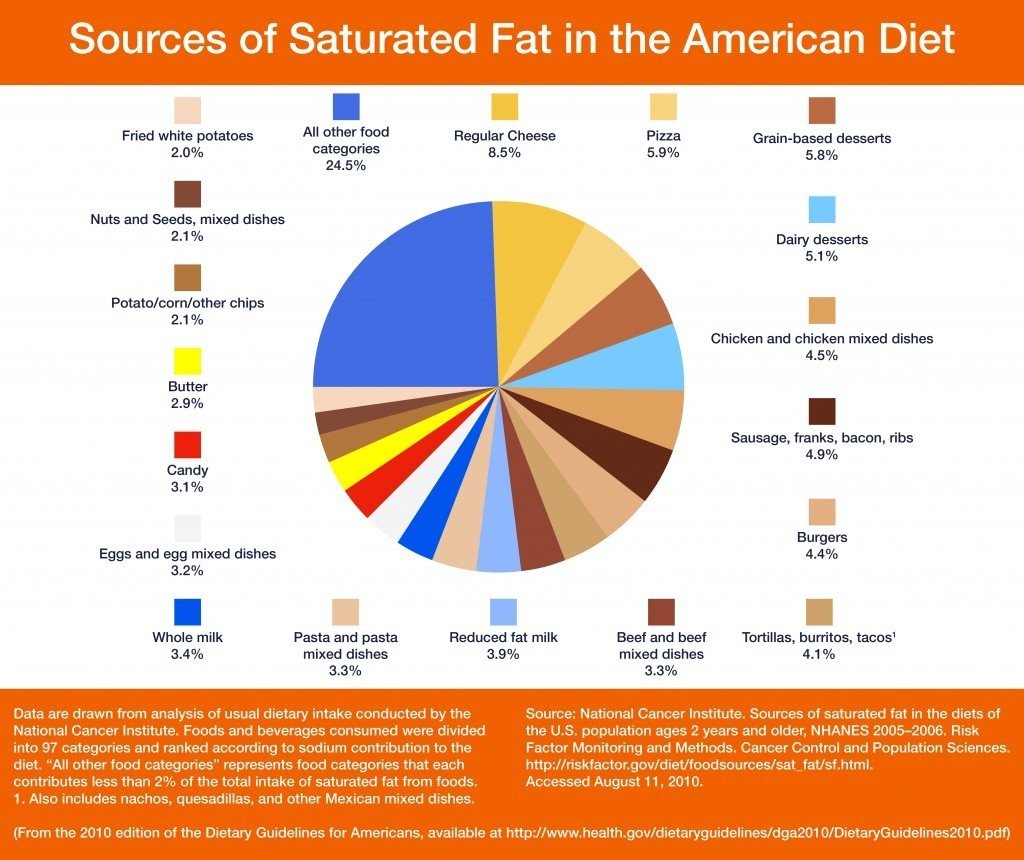 What Effect Does Saturated Fat Have on the Body?Unfortunately, when it comes to fat, most people eat too much saturated fat and not nearly enough of healthful unsaturated fats. This is bad news for health. After all, the Dietary Guidelines for Americans have revealed that "Even in the absence of overweight or obesity, consuming too much sodium, solid fats, saturated and trans fatty acids, cholesterol, added sugars, and alcohol increases the risk of some of the most common chronic diseases in the United States." MyPlate adds a bit more detail, asserting, "Saturated fats and trans fats tend to raise 'bad' (LDL) cholesterol levels in the blood. This, in turn increases the risk for heart disease."The good news is that reducing the saturated fat a person consumes can decrease his or her risk of these health dangers."Consuming less than 10 percent of calories from saturated fatty acids and replacing them with monounsaturated and/or polyunsaturated fatty acids is associated with low blood cholesterol levels, and therefore a lower risk of cardiovascular disease. Lowering the percentage of calories from dietary saturated fatty acids even more, to 7 percent of calories, can further reduce the risk of cardiovascular disease" (source).
What Effect Does Saturated Fat Have on the Body?Unfortunately, when it comes to fat, most people eat too much saturated fat and not nearly enough of healthful unsaturated fats. This is bad news for health. After all, the Dietary Guidelines for Americans have revealed that "Even in the absence of overweight or obesity, consuming too much sodium, solid fats, saturated and trans fatty acids, cholesterol, added sugars, and alcohol increases the risk of some of the most common chronic diseases in the United States." MyPlate adds a bit more detail, asserting, "Saturated fats and trans fats tend to raise 'bad' (LDL) cholesterol levels in the blood. This, in turn increases the risk for heart disease."The good news is that reducing the saturated fat a person consumes can decrease his or her risk of these health dangers."Consuming less than 10 percent of calories from saturated fatty acids and replacing them with monounsaturated and/or polyunsaturated fatty acids is associated with low blood cholesterol levels, and therefore a lower risk of cardiovascular disease. Lowering the percentage of calories from dietary saturated fatty acids even more, to 7 percent of calories, can further reduce the risk of cardiovascular disease" (source).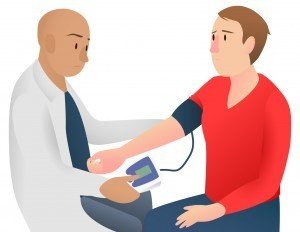 How Can People Reduce the Saturated Fat in Their Diets?Well, both saturated and unsaturated fats offer the same number of calories. The difference is in their health impact. That's why the Dietary Guidelines for Americans recommend that people "Consume less than 10 percent of calories from saturated fatty acids by replacing them with monounsaturated and polyunsaturated fatty acids." They continue, "Fat intake should emphasize monounsaturated and polyunsaturated fats, such as those found in seafood, nuts, seeds, and oils."Some of those changes can be easy.For example, consider dipping bread in olive oil rather than slathering it with butter. Or skip the butter again and sauté foods in vegetable oil. It's also a wise idea to replace a few meat dishes with fish -- most of the fats that fish contain are quite good for people.Other times, no saturated-for-unsaturated substitution is necessary. Simply reducing the amount of saturated fat you eat or drink can be good for your health. For example, try buying skim or 1% milk instead of whole milk. Do the same with cheese, yogurt, and milk-based puddings. It's also possible to lighten up the cuts of meat for purchase, choosing chicken breasts over thighs, lean beef over fattier cuts, etc.
How Can People Reduce the Saturated Fat in Their Diets?Well, both saturated and unsaturated fats offer the same number of calories. The difference is in their health impact. That's why the Dietary Guidelines for Americans recommend that people "Consume less than 10 percent of calories from saturated fatty acids by replacing them with monounsaturated and polyunsaturated fatty acids." They continue, "Fat intake should emphasize monounsaturated and polyunsaturated fats, such as those found in seafood, nuts, seeds, and oils."Some of those changes can be easy.For example, consider dipping bread in olive oil rather than slathering it with butter. Or skip the butter again and sauté foods in vegetable oil. It's also a wise idea to replace a few meat dishes with fish -- most of the fats that fish contain are quite good for people.Other times, no saturated-for-unsaturated substitution is necessary. Simply reducing the amount of saturated fat you eat or drink can be good for your health. For example, try buying skim or 1% milk instead of whole milk. Do the same with cheese, yogurt, and milk-based puddings. It's also possible to lighten up the cuts of meat for purchase, choosing chicken breasts over thighs, lean beef over fattier cuts, etc.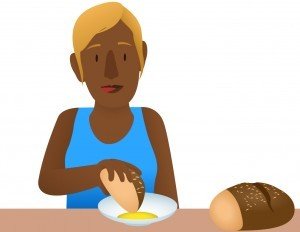 What do you want to know about saturated fat?For More Information:
What do you want to know about saturated fat?For More Information:
- Dietary Guidelines for Americans, 2010 Edition. http://health.gov/dietaryguidelines/dga2010/DietaryGuidelines2010.pdf
- Dietary Saturated Fat and Cardiovascular Health: A Review of the Evidence http://www.cnpp.usda.gov/sites/default/files/nutrition_insights_uploads/Insight44.pdf
- What Are Solid Fats? https://www.choosemyplate.gov/what-are-solid-fats
Here's a brand-new PDF handout, just for you!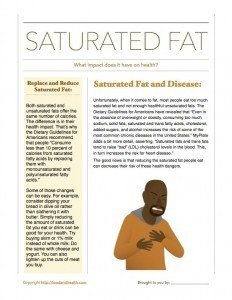 And there are lots of saturated fat education resources in the Nutrition Education Store. Here are 3 of the most popular options...
And there are lots of saturated fat education resources in the Nutrition Education Store. Here are 3 of the most popular options...

